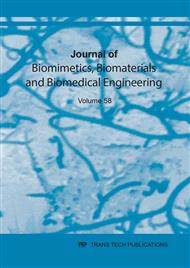[1]
Brügger, O E.; Bornstein, M. M., Kuchler, U.; Janner, S. F. M.; Chappuis, V.; & Buser, D. Implant therapy in a surgical specialty clinic: an analysis of patients, indications, surgical procedures, risk factors, and early failures. The International journal of oral & maxillofacial implants. 30 (2015) 151-160.
DOI: 10.11607/jomi.3769
Google Scholar
[2]
Swamidass, R. S.; Kan, J. Y. K.; Kattadiyil, M. T.; Goodacre, C. J.; & Lozada, J. Abutment screw torque changes with straight and angled screw-access channels. Journal of Prosthetic Dentistry. (2020).
DOI: 10.1016/j.prosdent.2020.01.018
Google Scholar
[3]
Cavallaro, J.; & Greenstein, G. Angled implant abutments: a practical application of available knowledge. The Journal of the American Dental Association. 142 (2011) 150-158.
DOI: 10.14219/jada.archive.2011.0057
Google Scholar
[4]
Dubois, G.; Daas, M.; Bonnet, A. S.; & Lipinski, P. Biomechanical study of a prosthetic solution based on an angled abutment: case of upper lateral incisor. Medical Engineering & Physics. 29 (2007) 989-998.
DOI: 10.1016/j.medengphy.2006.10.017
Google Scholar
[5]
Sethi, A.; Kaus, T.; Sochor, P.; Axmann-Krcmar, D.; & Chanavaz, M. Evolution of the concept of angulated abutments in implant dentistry: 14-year clinical data. Implant Dentistry. 11 (2002) 41-51.
DOI: 10.1097/00008505-200201000-00013
Google Scholar
[6]
Kao RT, Curtis DA, Kim DM, Lin GH, Wang CW, Cobb CM, et al. American Academy of Periodontology best evidence consensus statement on modifying periodontal phenotype in preparation for orthodontic and restorative treatment. Journal of Periodontology. 91 (2020) 289-298.
DOI: 10.1002/jper.19-0577
Google Scholar
[7]
Lee WZ, Ong MMA, Yeo AB. Gingival profiles in a select Asian cohort: a pilot study. Journal of Investigative and Clinical Dentistry. 9 (2018) e12269.
DOI: 10.1111/jicd.12269
Google Scholar
[8]
Qin, Yue, Burak, et al. Use of an attachment system with angulated abutments and polyetheretherketone inserts to retain a maxillary overdenture: A clinical report. The Journal of prosthetic dentistry. 124 (2019) 129-134.
DOI: 10.1016/j.prosdent.2019.07.013
Google Scholar
[9]
Spinato S, Galindo-Moreno P, Bernardello F, Zaffe D. Minimum abutment height to eliminate bone loss: influence of implant neck design and platform switching. International Journal of Oral & Maxillofacial Implants. 33 (2018) 405-411.
DOI: 10.11607/jomi.5604
Google Scholar
[10]
Blanco J, Pico A, Caneiro L, Nóvoa L, Batalla P, Martín-Lancharro P. Effect of abutment height on interproximal implant bone level in the early healing: a randomized clinical trial. Clinical Oral Implants Research. 29 (2018) 108-117.
DOI: 10.1111/clr.13108
Google Scholar
[11]
Chen Z , Lin C Y , Li J , et al. Influence of abutment height on peri-implant marginal bone loss: A systematic review and meta-analysis. The Journal of Prosthetic Dentistry. 122 (2019) 14-21.
DOI: 10.1016/j.prosdent.2018.10.003
Google Scholar
[12]
Cinel, S.; Celik, E.; Sagirkaya, E.; & Sahin, O. Experimental evaluation of stress distribution with narrow diameter implants: A finite element analysis. The Journal of Prosthetic Dentistry. 119 (2018) 417-425.
DOI: 10.1016/j.prosdent.2017.04.024
Google Scholar
[13]
Roy, S.; Das, M.; Chakraborty, P.; Biswas, J. K.; & Roychowdhury, A. Optimal selection of dental implant for different bone conditions based on the mechanical response. Acta of Bioengineering & Biomechanics. 19 (2017) 11-20.
Google Scholar
[14]
Cali, M.; Zanetti, E. M.; Oliveri, S. M.; Asero, R.; Ciaramella, S.; & Martorelli, M.. Influence of thread shape and inclination on the biomechanical behaviour of plateau implant systems. Dental Materials. 34 (2018) 460-469.
DOI: 10.1016/j.dental.2018.01.012
Google Scholar
[15]
SORO, N.; BRASSART, L.; CHEN, Y.; VEIDT, M.; ATTAR, H.; & DARGUSCH, M. S. FINITE ELEMENT ANALYSIS OF POROUS COMMERCIALLY PURE TITANIUM FOR BIOMEDICAL IMPLANT APPLICATION. MATERIALS SCIENCE AND ENGINEERING: A. 725 (2018) 43–50.
DOI: 10.1016/j.msea.2018.04.009
Google Scholar
[16]
JAYANTA, KUMAR, BISWAS, TIKESHWAR, PRASAD, & SAHU. DESIGN FACTORS OF LUMBAR PEDICLE SCREWS UNDER BENDING LOAD: A FINITE ELEMENT ANALYSIS. BIOCYBERNETICS AND BIOMEDICAL ENGINEERING. 39 (2019) 52-62.
DOI: 10.1016/j.bbe.2018.10.003
Google Scholar
[17]
DONG, WU, KEBIN, TIAN, JIANG, & CHEN. A FURTHER FINITE ELEMENT STRESS ANALYSIS OF ANGLED ABUTMENTS FOR AN IMPLANT PLACED IN THE ANTERIOR MAXILLA. COMPUTATIONAL AND MATHEMATICAL METHODS IN MEDICINE. 2015 (2015) 1-9.
DOI: 10.1155/2015/560645
Google Scholar
[18]
Okumura, N.; Stegaroiu, R.; Kitamura, E.; Kurokawa, K.; & Nomura, S. Influence of maxillary cortical bone thickness, implant design and implant diameter on stress around implants: a three-dimensional finite element analysis. Journal of Prosthodontic Research. 5 (2010) 133-142.
DOI: 10.1016/j.jpor.2009.12.004
Google Scholar
[19]
Bordin, D.; Bergamo, E. T. P.; Fardin, V. P.; Coelho, P. G.; & Bonfante, E. A. Fracture strength and probability of survival of narrow and extra-narrow dental implants after fatigue testing: in vitro and in silico analysis. Journal of the Mechanical Behavior of Biomedical Materials. 71 (2017) 244-249.
DOI: 10.1016/j.jmbbm.2017.03.022
Google Scholar



